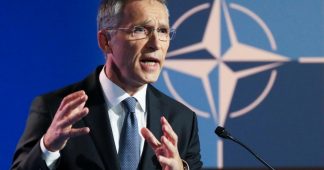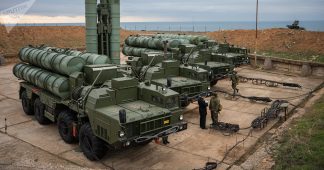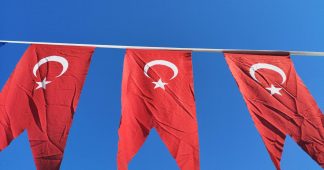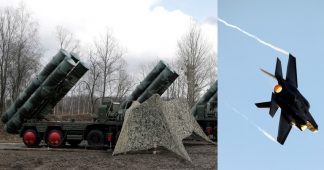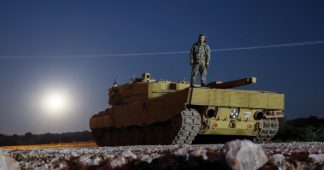On the first of the year the North Atlantic Treaty Organization transferred command of the NATO Very High Readiness Joint Task Force (VJTF) to Turkey.
On March 30 NATO turned over its current mission in Afghanistan to Turkish Brigadier General Selçuk Yurtsizoğlu.
In a phone conversation on April 1 U.S. Defense Secretary Lloyd Austin and Turkish Defense Minister Hulusi Akar discussed Turkey’s role in leading the NATO Resolute Support mission in Afghanistan among other matters.
Turkish Minister of Foreign Affairs Mevlut Cavusoglu met with U.S. Secretary of State Antony Blinken while both were attending the NATO meeting of foreign ministers and secretaries on March 23-24. (Blinken on the occasion: “Turkey is a long-standing and valued ally.”)
Speaking at an event in the U.S. on March 9 NATO Secretary General Jens Stoltenberg said: “I think that we need to understand that Turkey is an important ally. Because you can just look at the map and then you see that Turkey is extremely important.” [That final sentence is key and will be addressed later.]
A few days earlier Turkish President Recep Tayyip Erdoğan wrote on Twitter, “We would like to thank the NATO Secretary General for his objective evaluations on Euro-Atlantic security and defence matters.”
This is notwithstanding Turkey having supported and supervised if not directed last year’s 45-day war by Azerbaijan – the countries identify themselves (or itself) as “one nation, two states” – against minuscule Nagorno-Karabakh, its invasion of Northern Iraq thirteen years ago, its ongoing proxy war in Libya, its both direct and proxy war in Syria, its regular buzzing of fellow NATO member Greece’s aircraft in the Aegean Sea and its – now at 43 years – longest counterinsurgency war in the world against ethnic Kurds in its own country (which has spilled over into Iraq and Syria.) None of that in any manner disturbs NATO, the self-styled alliance of democracies.
What does distress the 30-member military bloc is that Turkey has purchased Russian-made S-400 anti-aircraft weapons. In doing so it has violated a cardinal tenet of NATO: one must only purchase NATO-interoperable weapons from fellow member states or partners like Sweden and Israel. Turkey’s unwillingness to cancel the purchase of the S-400s led to the U.S. suspending Turkey’s participation in the F-35 Joint Strike Fighter program (which the Biden administration has extended). When Greece expressed interest in purchasing the F-35s intended for Turkey, a Turkish official quipped that Ankara could use its S-400s to shoot down Greek F-35s.
The Western news media make much of the minor division over the S-400s but neglect to disclose the substantial and expanding role Turkey is playing in NATO’s plans for the Middle East and Asia, both areas strongly stressed as targets of growing involvement by Stoltenberg at the recent NATO foreign ministerial.
The above-quoted comment by NATO chief Stoltenberg about a look at the map establishing Turkey’s geostrategic importance to NATO is the simple truth. One impossible to miss. It is NATO’s only member in two continents, and its only member in Asia. It is the only member bordering the Middle East – Iran, Iran and Syria – and the Caucasus – Armenia and Georgia. It controls access from the Mediterranean Sea to the Sea of Marmara and from the Sea of Marmara to the Black Sea, which in turn gives exclusive access to the Sea of Azov.
Because of its location, in addition to U.S. air force and other military personnel stationed at the Incirlik Air Base and other locations in the nation, NATO has a presence at the Incirlik Air Base and at the Diyarbakir Air Base. (The second has been used for NATO operations starting in Bosnia in the 1990s and against Kurdish rebels in Turkey’s southeast.) In 2012, as NATO was intensifying its “drive to the south and east” (a State Department term), it transferred its Allied Land Command from Germany and Spain to Turkey. In the same year the alliance installed a Forward-Based X-Band Transportable anti-missile radar facility, with a range of 2,900 miles, in the country.
The U.S. maintains B61 nuclear bombs in Turkey under a NATO nuclear sharing/burden sharing arrangement which mandates that the host country provide aircraft to deliver the bombs.
Ahead of the U.S. and British attack on Iraq in 2003 NATO placed Patriot Advanced Capability-3 (PAC-3) missile batteries in Turkey. In 2013 NATO agreed to place six PAC-3 batteries near the Turkish-Syrian border to “protect against ballistic missiles.” Two years later Turkey called a NATO Article 4 consultation to request the alliance’s support for its role in Syria – in both the above cases as though it were the victim and not the aggressor.
Turkey is the second-most populous nation in NATO, and the most populous in Europe and Eurasia. It is also second only to the U.S. in the number of troops it has under arms: 437,000. It contributes over $100 million a year to NATO common funds.
Exploiting a seemingly incongruous but to date highly effective strategy of combining neo-Ottoman pan-Turkism, Sunni pan-Islamism and the role of NATO’s eastern and southern vanguard, Ankara has now positioned itself as a major player in North Africa, the Middle East, the Balkans, the Caucasus and increasingly in Central Asia, which is to say in the last two examples former parts of the Soviet Union and historical Russia.
Regarding last year’s war against Nagorno-Karabakh and the fact that Turkey’s role had not only not drawn even mild censure from NATO – far from it, NATO’s Stoltenberg visited the Turkish capital only a few days after the war was launched – Lebanese scholar Yeghia Tashjian recently described it succinctly but comprehensively:
“Less than half a year has passed since the insolent aggression of Azerbaijan and Turkey against Artsakh [Nagorno-Karabakh] and Armenia. A NATO member country, using NATO weapons, committed a brazen act of aggression. Meanwhile, Turkey openly used terrorists from the Middle East….Disregarding numerous facts about the direct involvement of militants of terrorist groups by Turkey, the NATO Secretary-General [last week praised] the role of Turkey in the fight against terrorism.”
Shortly after the “one nation, two states” (with a combined population of 95,000,000) fought a 45-day one-sided war against Nagorno-Karabakh (with a population of 145,000), Turkish President Recep Tayyip Erdoğan was the guest of honor at the postwar victory [if that is the word] parade in the capital of Azerbaijan on December 10, where among other matters he praised Enver Pasha, one of the key architects of the Armenian genocide of the last century, and read a poem condemning the “division of Azerbaijani territory” between Iran and Russia in the 1800s. Iran has a sizable Azeri-Turkic minority that could be exploited by Azerbaijan and Turkey, with the U.S. and Israel behind them, to create a 1990s Yugoslavia scenario of attempting to splinter the nation with separatist movements. Estimates of the number of ethnic Azeris in Iran range as high as 19 million (about twice the population of Azerbaijan itself), and their percentage of the total population as high as 20 percent.
As a result of Erdoğan’s poetry reading in Baku, the Iranian Foreign Ministry summoned Turkey’s ambassador to Tehran. “The Turkish ambassador was informed that the era of territorial claims and expansionist empires is over,” Iran’s Foreign Ministry said on its website.
“Iran does not allow anyone to meddle in its territorial integrity.”
As the Turkish military plays a more prominent, indeed dominant, role in NATO’s mission in Afghanistan, where NATO troops now outnumber American ones, Ankara will expand its pan-Turkic influence in that country and throughout Central Asia. Abdul Rashid Dostum, Afghan vice-president from 2014-2020 and a Turkic-speaking ethnic Uzbek, lived in Turkey much of the first decade of the century and can safely be assumed to be a Turkish asset.
Kazakhstan, Kyrgyzstan, Turkmenistan and Uzbekistan have majority Turkic-speaking populations. Tajikistan (1.2 million) and Russia (13 million) have sizable Turkic-speaking minorities.
The Uyghurs in China’s Xinjiang Uyghur Autonomous Region are ethnic Turkic. Uyghur separatists refer to the region as East Turkestan. The East Turkestan Liberation Organization of the early 2000s was established in Turkey in the 1990s.
NATO and Turkey. Bridgehead and spearhead. Just look at the map.
Published at antibellum679354512.wordpress.com
